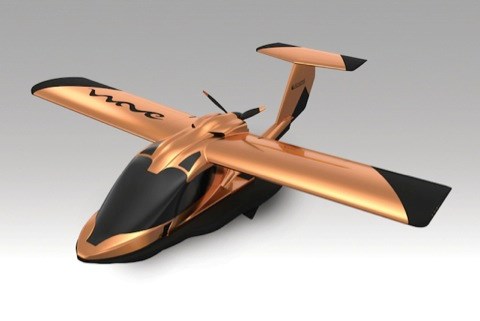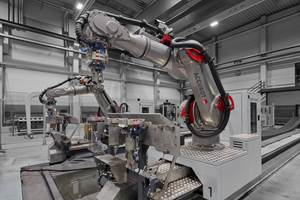A surge in seaplanes?
The current bright spot in general aviation might be in light-sport aircraft (LSA), and more specifically in seaplanes.

The Vickers Wave seaplane is a true composite, built from an aluminum primary structure surrounded by a carbon fiber hull.
The current bright spot in general aviation, according to a March 30 online article by Dan Johnson of General Aviation News, is light-sport aircraft (LSAs, see the original article here: ). Johnson says that as LSAs approach the end of their first decade this summer, 134 models have already been created and gained FAA acceptance, an impressive pace that represents more than one new design every month for 10 years running.
In 10 years, LSA have morphed from ultralight or light kit aircraft into a fleet of modern and capable aircraft manufactured under industry consensus standards. In 2014 it is becoming clear that the LSA industry is embarking on a new level of achievement; some of the most intriguing of these, says Johnson, are seaplanes.
Icon stimulated the market for these advanced ships with fresh ideas and creative engineering. A team from Scaled Composites (key participants in the creation of SpaceShipOne and many unique aircraft) joined Icon to produce the A5. The Southern California company reportedly has more than 1,000 aircraft orders. While Team Icon works to assemble a manufacturing system, other seaplane designs are coming into view. In addition to several proven designs, including Searey, Super Petrel, SeaMax and Mermaid that are all presently accepted by FAA as Special LSAs (SLSA), Freedom, Aventura, and Atol are also in the mix (a review of most of these can be found at www.bydanjohnson.com/Sidebar.cfm?Article_ID=1732).
Yet among LSA seaplanes, the next generation wave is building and Johnson expects additional designs to emerge this year. Among them are some of the most technically sophisticated flying machines in the entire LSA space.
Consider this: The Lisa Akoya, Icon’s A5, the Vickers Wave, and one other unidentified company have all secured substantial funding from Chinese investors. They join such notable aviation enterprises as Cirrus Aircraft, Continental Motors, Flight Design, Superior Air Parts and others in securing Chinese investment. In the case of the LSA seaplanes, the investors are not taking over the companies and appear primarily focused on the China market, says Johnson.
Lisa’s Akoya, priced near $400,000, is a unique design that in some ways attempts to surpass Icon’s A5. Both are flying at present, but neither has gone to the conforming prototype stage, according to Johnson (see the ÂÌñÏ×ÆÞ blog about Lisa Airplanes dated 1/31/14).
The groundbreaking Wave from Vickers Aircraft in New Zealand has reportedly received funding from Chinese investors, which could accelerate its seven-year-old design project so that it can take to the skies this summer.
Wave (pictured) has several popular characteristics, such as powered folding wings, sliding doors, enough aft cabin space to allow a four-seat design in the future, and specialized landing gear involving as many as seven wheels. Wave’s “Cross-Over” landing gear does not need to be retracted, which eliminates some weight and reduces pilot workload. The gear pivots enough to aid crosswind landings on hard surfaces.
Wave is a true composite, built from an aluminum primary structure surrounded by a carbon fiber hull. As parts go together in prototype number one, Vickers said all parts are matching the weights as predicted by state-of-the-art computer design software.
As with every design since the Wright brothers’ first biplane 111 years ago, the proof of design will be found in the flying, but Wave, A5, Akoya, and others yet to be identified are showing the LSA seaplane subcategory to be a fountain of engineering prowess.
See the original article here:
Related Content
First Airbus A350 crash confirmed in Haneda
Shortly after touch-down, a JAL A350-900 aircraft recently collided with a De Havilland Canada Dash 8. Exact circumstances are still unknown.
Read MoreInfinite Composites: Type V tanks for space, hydrogen, automotive and more
After a decade of proving its linerless, weight-saving composite tanks with NASA and more than 30 aerospace companies, this CryoSphere pioneer is scaling for growth in commercial space and sustainable transportation on Earth.
Read MoreOtto Aviation launches Phantom 3500 business jet with all-composite airframe from Leonardo
Promising 60% less fuel burn and 90% less emissions using SAF, the super-laminar flow design with windowless fuselage will be built using RTM in Florida facility with certification slated for 2030.
Read MoreAutomated robotic NDT enhances capabilities for composites
Kineco Kaman Composites India uses a bespoke Fill Accubot ultrasonic testing system to boost inspection efficiency and productivity.
Read MoreRead Next
Next-gen fan blades: Hybrid twin RTM, printed sensors, laser shock disassembly
MORPHO project demonstrates blade with 20% faster RTM cure cycle, uses AI-based monitoring for improved maintenance/life cycle management and proves laser shock disassembly for recycling.
Read MoreUltrasonic welding for in-space manufacturing of CFRTP
Agile Ultrasonics and NASA trial robotic-compatible carbon fiber-reinforced thermoplastic ultrasonic welding technology for space structures.
Read MoreCeramic matrix composites: Faster, cheaper, higher temperature
New players proliferate, increasing CMC materials and manufacturing capacity, novel processes and automation to meet demand for higher part volumes and performance.
Read More












